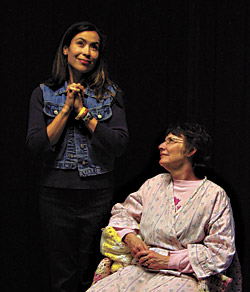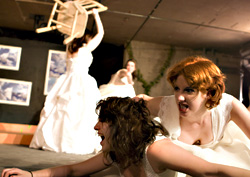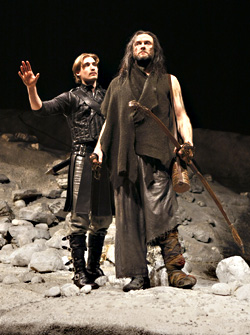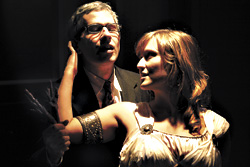When I first saw the then-obscure real-estate movie It’s a Wonderful Life in R.T. Jameson’s UW film class, I was bowled over, but I bitterly knew that I would never get a dream house like the old Granville mansion at 320 Sycamore St., in which penniless Jimmy Stewart and Donna Reed live happily ever after, thanks to Clarence the angel. I was an English major in the real world, not a character in a plutocrat-bashing wish-fulfillment fantasy.
My envy re-erupted when I started moonlighting as a Sears bill collector and ran across Donna Reed’s file. If only she’d fall behind on her bills! I could get even by visiting her Seattle-area mansion dressed as Lionel Barrymore, jab her with my cane, and hiss, “The Reed family has been a boil on Sears’ neck long enough! I’m repossessing your home and throwing you in the street!”
My Mr. Potter mood lifted when my own life got wonderful. A kindly, Clarence-esque millionaire prof gave me an all-expenses school loan to be paid back whenever, interest-free. This helped me somehow save $3,000 on a Seattle Weekly salary starting at $80 a week (this was back in 1978, good English-major money for the time). The little old lady next door begged me to buy her teensy $60,000 U Village bungalow on an FHA loan. For $3,000 down.
After marriage and 19 years, however, the 800-square-foot bungalow felt teensier. We craved a bigger place to accommodate my office and my wife’s art studio. So we plunged into a grueling two-year expedition into the surreal world of Seattle real estate—what I call the Great Fear Market of the 21st century. Never before have so many made so much money from real estate in a climate with so little optimism and such bitten-to-the-quick fingernails. During the stock-market bubble, at least we had the comfort of our delusions. Sure, a modest correction seemed inevitable, but even so, the overall trend was up, the future so bright we had to wear designer shades.
Today we buy like there’s no tomorrow, because there may not be one. Either prices will soar out of sight, so we’d better buy now—or soar and crash, leaving us busted like Jimmy Stewart in the dream-house-turned-nightmare-shack in Capra’s film-noir sequence. Crafty old Alan Greenspan (Mr. Potter in disguise?) talked millions into buying adjustable-rate mortgages just before he jacked up interest rates, to help banks and get Bush re-elected, fueling what The Economist magazine calls the biggest real-estate boom in recorded history. Now, we may be facing a 10 percent to 20 percent correction. Dean Baker of Washington, D.C.’s Center for Economic and Policy Research guesses it’ll be more like 20 percent to 40 percent when you adjust for inflation.
“Seattle would probably be somewhat on the high side,” Baker tells me. “People are willing to pay anything for a place because they’re absolutely convinced it’s only going to cost more a year from now, two years from now, three.” On a less alarmist note, other experts predict no housing crash, just a gentle leveling, and some of them aren’t even government spinmeisters or industry mouthpieces.
Bubble or no bubble, people gotta live somewhere, and my wife and I still needed more space. After the 2000 Nasdaq crash, like everybody else, we fled Wall Street like it was Shelob’s cave in Return of the King. We quit speculating and began to bet the ranch on . . . the ranch.
But which ranch? Our indefatigably chipper real-estate agent, Windermere’s Julie Friedman, proposed hundreds of houses, and we found others on our own. All had something going for them. And something going against. Mad architecture. Delusional sellers demanding twice the price of equivalent homes right next door. Huge, ruined concrete ponds. Fancy fireplaces adorned with ziggurats of dried cat turds. Disintegrating cliff-side sites. Saloon doors that swung back and smacked your ass. One place seemed a great deal, until we noticed the sign noting the imminent construction of two new houses in the backyard. Another had a roofline that, instead of featuring an A-shaped peak, was designed in a steep V shape resembling the graph of current interest rates. And there turned out to be two sides to gentrification: Two doors down, a millionaire neighbor discovered a murdered prostitute dumped outside his dream-house window.
Meanwhile, as we were looking between 2002 and 2004, prices kept rising while our savings kept dwindling. We set up firm top price after firm top price; each gave way faster than Ado Annie on Viagra. Julie kept saying plaintively, “But that’s what things cost in Seattle now!”
She also informed us that old rules were out the window. We lost swoony homes by cautiously putting in a first bid under the asking price. Soon we were losing by offering the asking price. For hot houses, Julie warned us not to slow things down by oldfangled notions like requesting an inspection. Do it the morning of the afternoon you submit the offer.
We also learned about the practice of writing an essay in support of our purchase offer. Another of our agent wanna-bes, Re/Max’s Jeff Sackett, explains, “In the last five listings I’ve sold, twice they’ve done essays,” he says. “But I don’t like buyers to do it. The warm fuzzies are one thing, but if your essay offends them, it backfires big. The letter I wanna see is a preapproval letter from the bank.” Yet both he and Friedman have had cases where a seller actually took less money to get a preferred buyer— a teacher, say, or somebody who’ll maintain a property the way the original owners intended.
One example is former SW scribe Bruce Barcott, who says of his $20K knock-down, “The whole essay-writing thing leaves me a little queasy. We won our lovely little Phinney bungalow by submitting a whole essay packet. And I do mean ‘won.’ Ours was one of seven or 10 offers, at least one of which offered more money than we did. But the previous owner was a kind soul, a devout Buddhist and a writer himself, and he took a shine to our chi.”
I wouldn’t want to match my chi against Bruce Barcott’s, but I braced myself for the abject essay contest if it came to that. Would I be willing to bare my soul to a perfect stranger, to essentially beg for the right to hand him my life savings? You bet I would.
Then, very shortly before my wife and I made a suicide pact to escape the Seattle real-estate market, Julie phoned me this past May. “I think you should come look at this house by Carkeek Park.” Oh, all right, I sighed. How about Monday? “No, I think you should come see it right now.” Skeptically, I went off to see the 200th-plus house of my alleged dreams. Shockingly, it actually worked: big open spaces, skylights, Brazilian cherry-wood floors, room to ramble—and less than twice what we’d originally intended to pay.
Julie was right to rush us. The place immediately attracted buyers like mosquitoes to the first camper of the season in Denali National Park. Essay time, advised Julie. I raced to my computer. Having noted the many bird feeders in the yard, I composed an essay stressing the love my wife and I have for bird-intensive, woodsy homes. (Carkeek Park is habitat to 24 species of birds, an improvement over our old U Village backyard, dominated by amusingly loudmouth crows and a pair of quarrelsome squirrels we called the Bickersons.) Bingo. Days later, the owners handed over the keys and the bird feeders. It’s no mansion. But it’s a wonderful house.







